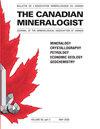Taniajacoite and Strontioruizite, Two New Minerals Isostructural with Ruizite from the N'Chwaning III Mine, Kalahari Manganese Field, South Africa
IF 1.5
4区 地球科学
Q3 MINERALOGY
引用次数: 1
Abstract
Two new mineral species, taniajacoite and strontioruizite, ideally SrCaMn2Si4O11(OH)4 2H2O and Sr2Mn2 Si4O11(OH)4 2H2O, respectively, have been identified from the N’Chwaning III mine, Kalahari manganese field, South Africa. Both minerals occur as brown radiating groups or aggregates of acicular or prismatic crystals, with individual crystals up to 0.15 3 0.04 3 0.02 mm for taniajacoite and 1.3 3 0.2 3 0.2 mm for strontioruizite. Minerals associated with taniajacoite include sugilite, aegirine, pectolite, richterite, potassic-ferri-leakeite, and lipuite, whereas those associated with strontioruizite include sugilite, potassic-magnesio-arfvedsonite, and lipuite. Both taniajacoite and strontioruizite are brown in transmitted light, transparent with very light brown streak and vitreous luster. They are brittle and have a Mohs hardness of 5–5.5; cleavage is good on {010} and no parting or twinning is observed macroscopically. The measured and calculated densities are 3.05(2) and 3.09 g/cm, respectively, for taniajacoite and 3.20(2) and 3.16 g/cm for strontioruizite. Optically, both taniajacoite and strontioruizite are biaxial (–), with a1⁄4 1.686(2), b1⁄4 1.729(2), c1⁄4 1.746(2) (white light), 2V (meas.)1⁄4 63.7(5)8, 2V (calc.)1⁄4 62.58 for the former and a1⁄4 1.692(2), b1⁄4 1.734(2), c1⁄4 1.747(2) (white light), 2V (meas.)1⁄4 59.1(5)8, 2V (calc.)1⁄4 56.68 for the latter. The calculated compatibility index based on the empirical formula is 0.008 for taniajacoite and 0.015 for strontioruizite. An electron microprobe analysis yielded an empirical formula (based on 17 O apfu) of Sr(Ca0.81Sr0.19)R1.00(Mn 3þ 1.90Fe 3þ 0.15 Al0.01)R2.06Si3.96O11(OH)4 2H2O for taniajacoite and (Sr1.61Ca0.42)R2.03(Mn1.95Fe0.05)R2.00Si3.98O11(OH)4 2H2O for strontioruizite. Taniajacoite and strontioruizite are isostructural with ruizite. Strontioruizite, like ruizite, is monoclinic with space group C2 and unit-cell parameters a 1⁄4 9.1575(4), b 1⁄4 6.2857(4), c 1⁄4 12.0431(6) Å, b 1⁄4 91.744(4)8, and V 1⁄4 692.90(6) Å, whereas taniajacoite is triclinic, with space group C1 and a1⁄49.1386(5), b1⁄46.2566(3), c1⁄412.0043(6) Å, a1⁄490.019(4), b1⁄491.643(4), c 1⁄4 89.900(4)8, and V 1⁄4 686.08(6) Å. Their structures are characterized by chains of edge-sharing MnO6 octahedra extended along [010], which are linked together by corner-shared SiO4 tetrahedra in four-membered [Si4O11(OH)2] linear clusters, giving rise to a so-called ‘‘hetero-polyhedral framework’’. The large cations Sr2þ and Ca2þ occupy the seven-coordinated interstices. Unlike monoclinic ruizite and strontioruizite, taniajacoite with Sr:Ca ’ 1:1 is triclinic, owing to the ordering of Sr2þ and Ca2þ into two crystallographically distinct sites, indicating an incomplete solid solution between Ca and Sr endmembers. The unitcell volumes for ruizite, taniajacoite, and strontioruizite appear to vary linearly with the Sr/(Ca þ Sr) ratio.Taniajacoite和Strontioruizite,南非卡拉哈里锰田N'Chvending III矿与Ruizite同构造的两种新矿物
在南非卡拉哈里锰田N'Chvening III矿中发现了两种新的矿物,taniajacoite和strontioruzite,最好分别为SrCaMn2Si4O11(OH)4 2H2O和Sr2Mn2 Si4O11。这两种矿物都以针状或棱柱状晶体的棕色辐射团或聚集体的形式出现,钽铁矿的单个晶体高达0.15 3 0.04 3 0.02 mm,锶钛矿的单个晶体为1.3 3 0.2 3 0.2 mm。与钽铁矿相关的矿物包括苏铁榴石、赤铁矿、果胶岩、富镁石、钾铁榴石和锂辉石,而与锶钛榴石相关的矿物则包括苏铁铁矿、钾镁铝榴石和钙辉石。taniajacoite和strontioruizite在透射光下均为棕色,透明,具有非常浅的棕色条纹和玻璃光泽。它们很脆,莫氏硬度为5-5.5;{010}上的解理良好,宏观上没有观察到分离或孪晶。钽铁矿的测量密度和计算密度分别为3.05(2)和3.09 g/cm,锶钛矿的测量密度为3.20(2),计算密度为3.16 g/cm。在光学上,钽铁矿和锶辉石都是双轴的(–),前者为a1⁄4 1.686(2),b1⁄4 1.729(2)、c1⁄4 1.766(2)(白光),后者为2V(测量值)1⁄4 63.7(5)8、2V(计算值。根据经验公式计算出的相容性指数,对于钽铁矿为0.008,对于锶锑矿为0.015。电子探针分析得出了Sr(Ca0.81Sr0.19)R1.00(Mn3þ1.90Fe3 \254\0.15Al0.01)R2.06Si3.96O11(OH)4 2H2O对钽铁矿和(Sr1.61Ca0.42)R2.03(Mn1.95Fe0.05)R2.00Si3.98O11(OH4 2H2O。Taniajacoite和strontio-ruizite与ruizite为同构造。Strontioruizite和ruizite一样,是单斜晶系,空间群为C2,晶胞参数为a 1⁄4 9.1575(4)、b 1⁄4.6.2857(4 4 89.900(4)8和V 1⁄4 686.08(6)Å。它们的结构特征是沿[010]延伸的边缘共享MnO6八面体链,这些八面体通过四元[Si4O11(OH)2]线性团簇中的角共享SiO4四面体连接在一起,产生了所谓的“异质多面体框架”。大阳离子Sr2和Ca2占据了七个配位间隙。与单斜锐钛矿和锶锶矿不同,Sr:Ca'1:1的钽酸钙石是三斜的,这是由于Sr2þ和Ca2þ;排列成两个晶体上不同的位置,表明Ca和Sr端基之间存在不完全固溶体。锐锌矿、钽铁矿和锶锶矿的晶胞体积似乎随Sr/(CaþSr)比线性变化。
本文章由计算机程序翻译,如有差异,请以英文原文为准。
求助全文
约1分钟内获得全文
求助全文
来源期刊

Canadian Mineralogist
地学-矿物学
CiteScore
2.20
自引率
22.20%
发文量
45
审稿时长
4-8 weeks
期刊介绍:
Since 1962, The Canadian Mineralogist has published papers dealing with all aspects of mineralogy, crystallography, petrology, economic geology, geochemistry, and applied mineralogy.
 求助内容:
求助内容: 应助结果提醒方式:
应助结果提醒方式:


